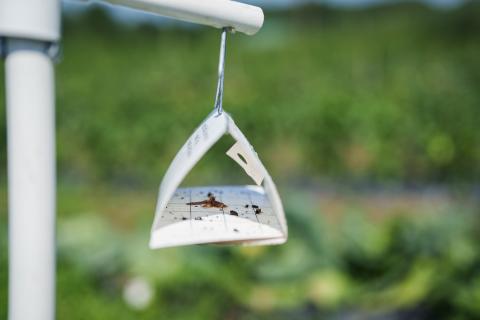Setting the Trap
On a warm morning in August, Linda Kunhardt walks among rows of corn to check traps. As an integrated pest management (IPM) scout for UNH Extension, she collects information about pests that helps growers save time and money, while lessening environmental impacts.
Pests that harm agricultural operations may include insects, mites, diseases, weeds, snakes, rodents and larger vertebrates. When it comes to vegetable crops, sweet corn is an important commodity — by acreage, it’s the No. 1 vegetable crop grown in New Hampshire.
Three prominent insects threaten sweet corn: corn earworm, fall armyworm and European corn borer. These unwelcome insects are caterpillars that mature into moths.
Conventional methods to eliminate pests include applying chemical insecticides on a calendar schedule or based on growth stage, regardless of whether pests are present. But in the 1970s, concerns arose about the environmental effects of insecticides, as well as increasing insecticide costs. The federal government encouraged states to implement IPM, an ecological approach to pest control that combines several techniques to maintain pests below damaging levels.
UNH Extension has been helping growers through the IPM program since 1978. Entomologist Alan Eaton and field specialist George Hamilton, now both retired, originally built the program specifically to help sweet corn growers, but efforts expanded to include monitoring for insects that affect pumpkins and squash, as well as small fruit. Funding is provided by the New Hampshire Department of Agriculture, Markets and Food.

Linda Kunhardt next to an IPM trap.
Strategic Monitoring
UNH Extension’s current entomology and IPM state specialist, Amber Vinchesi-Vahl, explains that an important component of IPM is insect trapping and monitoring. Extension uses various types of traps, including pheromone-based ones, which collect insects that are counted and reported by Kunhardt.
“Monitoring allows us to know when they’re arriving each year, and when we can expect to start seeing larval feeding damage or caterpillar feeding damage,” Vinchesi-Vahl says.
Reports are emailed to growers, posted on Extension’s website and even sent by text.
Twenty-eight farms participate in the vegetable program, mostly in Hillsborough and Merrimack counties, which includes over 600 acres of sweet corn in the state — that’s 59% of the acreage that’s planted in New Hampshire.

Economic and Environmental Benefits
“By basing pesticide use on crop vulnerability and pest monitoring, spraying is done only when it is needed,” Vinchesi-Vahl says.
Reducing sprays lessens the risk of pests becoming resistant to pesticides, killing beneficial organisms, farm worker exposure to pesticides and other possible negative environmental effects like contaminated water.
During the summer, Kunhardt visits farms weekly. In addition to her scouting, a handful of growers set and monitor their own traps, which are provided by Extension.
In 2023, sweet corn growers participating in the IPM program in New Hampshire reported saving two pesticide sprays, a monetary impact of $240,000 when factoring in the cost of pesticides, labor and equipment. Growers also reported a net increase of over 8% in sweet corn available for sale, due to the reduction in insect-damaged ears. Squash and pumpkin growers reported saving an average of three pesticide sprays across 232 acres, which meant over 170 gallons of insecticides were not applied, saving almost $28,000.
“If you’re spraying at the right time, you’re going to have better control and then therefore increase your yield,” Vinchesi-Vahl says.
Extension Services & Tools That Help NH Farmers Grow
Newsletters: Choose from our many newsletters for production agriculture
Receive Pest Text Alerts - Text UNHIPM to (866) 645-7010


